
Because of recent threats of bioterrorism, smallpox vaccination was reinstated in the United States earlier this year. Since January 2003, more than 35,000 civilian and public health care workers in 54 jurisdictions have been vaccinated.

Because of recent threats of bioterrorism, smallpox vaccination was reinstated in the United States earlier this year. Since January 2003, more than 35,000 civilian and public health care workers in 54 jurisdictions have been vaccinated.

Foot ulcerations and infections are the leading cause of hospitalization amongpatients with diabetes; they occur in about 15% of these patients.

A slightly pruritic, red, scaly rash on an 8-year-old boy’shands has been progressively worsening since it appeared4 months earlier. Nail pitting also was noted. There are noother rashes on his body. The patient is active in sports;denies any new exposure to soaps, clothing, or other contactants;and spends time in the homes of his recently divorcedparents.

This condition features acutely tender nodules, marked erythema, and contusions that appear as a consequence of inflammation of subcutaneous fat.
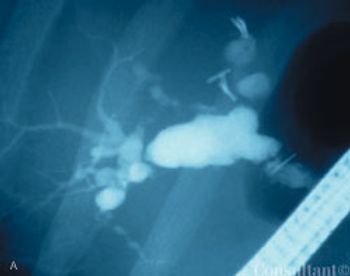
A 41-year-old man complained of upper abdominal pain and malaise of several months duration. He had emigrated to the United States from Korea 5 years earlier.

An obese 55-year-old woman had intermittent dysuria and frequent urination for 4 days and fever, abdominal pain, and vomiting for 3 days. Her history included type 1 diabetes mellitus, hypertension, and angina; her medications included insulin, nifedipine, and nitroglycerin.

Many of my patients are confused. So aremany of my colleagues. Official bodies ofexperts barrage the media with pronouncementson what constitutes goodpreventive medicine: screening tests, eatingor abjuring certain foods, avoidance of exposures tosun or environmental hazards, "correct" behaviors. Althoughthey acknowledge that the data are, and alwayswill be, imperfect, these experts try their best to directpeople in the way that the evidence points-for now.

Reiter Syndrome (also called reactive arthritis) manifests as peripheral arthritis that is sometimes accompanied by such extra-articular findings as urethritis, conjunctivitis, and uveitis

n the United States, the number of cases and geographic range of West Nile virus infection have increased since 1999, when the virus first surfaced in the Western Hemisphere. This year, the virus is expected to spread to all states except Alaska and Hawaii.

ABSTRACT: Many patients with presumed mild intermittent asthma have unrecognized persistent symptoms; these can be elicited with specific questioning about coughing, wheezing, shortness of breath, chest tightness, nighttime awakenings, and exercise intolerance. Asthma severity may vary with the season. For asthmatic patients with predictable seasonal allergies, prescribe inhaled corticosteroids for a few weeks or months beginning 2 to 3 weeks before usual symptom onset. Successful long-term management requires identification and control of asthma triggers, such as cigarette smoke, house dust mites, cockroaches, molds, and animal dander. Removing triggers or minimizing the patient's exposure to them may allow improved asthma control with lower dosages of corticosteroids.
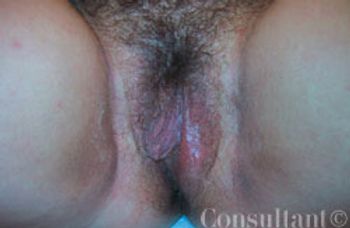
At 37 weeks' gestation, a 27-year-old woman (gravida 1, para 0) presented with increasing vaginal pain and a yellowish white discharge of 1 week's duration. Despite use of a topical antifungal prescribed by another practitioner, the symptoms worsened and a vaginal mass suddenly appeared. The patient denied any history of sexually transmitted disease.

Twenty-four hours after a car accident, a 47-year-old man with chronic low back pain-which had been diagnosed years earlier as "arthritis" of the spine-presented with back and chest pain and requested an opioid analgesic. The patient had a history of alcoholism and illicit drug use. Tenderness of the thoracic area was noted.
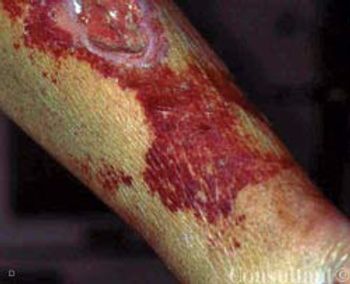
A 59-year-old man, who was unable to walk, was brought to the emergency department with severe leg pain, worsening weakness, increasing fatigue, chills, and fever of 3 days' duration. The symptoms began after a round of golf. In addition to the leg pain, which particularly affected the calf muscles, the lower extremities were red and swollen.

ABSTRACT: When a patient presents with low back pain, ask about the location and quality of the pain, what makes the pain increase or decrease, associated symptoms, and risk factors. Clues to systemic causes of low back pain include fever; arthritis; iritis; signs and/or symptoms of GI disease, pelvic disease, or renal disease; tachycardia; and integumentary abnormalities. Perform a neurovascular evaluation as well as a detailed musculoskeletal examination. Imaging studies are not necessary for most patients initially. Acute therapy consists of the application of cold and heat and analgesics such as acetaminophen or an NSAID. Early exercise-not bed rest-is the cornerstone of treatment. Follow-up is mandatory: in 3 to 7 days for patients with severe pain, inconsistent findings, mild neurologic abnormalities, or a history of progres- sive symptoms; and in 10 to 14 days for patients with no neurologic compromise.
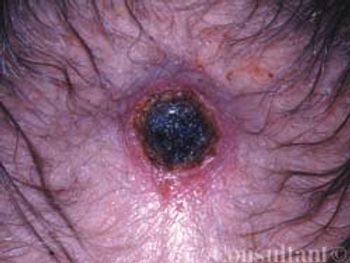
An ulcerated lesion that measured approximately 2 cm in diameter had developed on an 80-year-old woman's scalp. The lesion featured a dark eschar that covered a slightly elevated, erythematous border. According to the patient's husband, a different lesion had been at the site 2 weeks earlier. He described the original as a "ball" that ulcerated, had no drainage, and formed a scab.
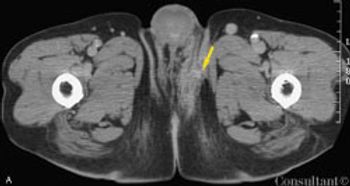
A 77-year-old African American man with type 2 diabetes mellitus and coronary artery disease presented to the emergency department with acute scrotal swelling and pain. His testicles were erythematous with focal areas of necrosis and associated tissue destruction. Similar skin changes were apparent in the lower abdominal and inguinal regions.
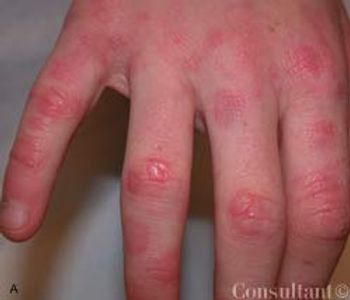
Several asymptomatic, erythematous papules and plaques had appeared on the hands of an otherwise healthy 11- year-old girl. The personal and family medical histories were noncontributory.

A 63-year-old woman presents withdiffuse hyperkeratosis of the solesand palms. She also has onycholysis-separation of the nail plate fromthe nail bed-and salmon-coloredplaques behind her ears. Biopsy ofone of the plaques confirms the suspecteddiagnosis of psoriasis.

A middle-aged man with"jock itch" that has failed torespond to antifungal creams.An older woman who has diffusehyperkeratosis of predominantlyweight-bearing surfaces.A young man with mildlypruritic, small, salmon pinkpapules and thick white scaleon his trunk and arms.

A 30-year-old man presents with scalingand erythema of the scalp that extendspast the anterior hairline. Thepatient has a family history of psoriasis.For the past 5 years, he has experiencedwintertime flares of the diseasethat affect his scalp and the extensorsurfaces of the extremities.

A 46-year-old man complains that his"jock itch" failed to respond to antifungalcreams. The patient has hadpsoriasis on his elbows and knees formany years.

A 72-year-old man presents with skinlesions and nail abnormalities. Erythematous,sharply defined, demarcatedpapules and rounded plaquescovered by silvery micaceous scaleare noted on the elbows, knees, andscalp. Involved areas appear to be bilaterallysymmetric. Localized psoriasisvulgaris is diagnosed.

4A:Small, slightly pruritic, salmonpink papules with thick white scalehave arisen over the past 5 days onthe trunk and arms of a 24-year-oldman. The patient has a history ofvery mild psoriasis vulgaris of the elbows,knees, and scalp; he deniesstreptococcal pharyngitis or other recentinfections. Guttate psoriasis isdiagnosed.

Focal, painless discoloration of theleft thumbnail (A) developed severalyears earlier in this 46-year-old man.Oral antifungal therapy had no effecton the lesion.

A 35-year-old man presents with extensiveplaques over much of thetrunk and extremities. This severeflare of psoriasis developed after astressful emotional experience.